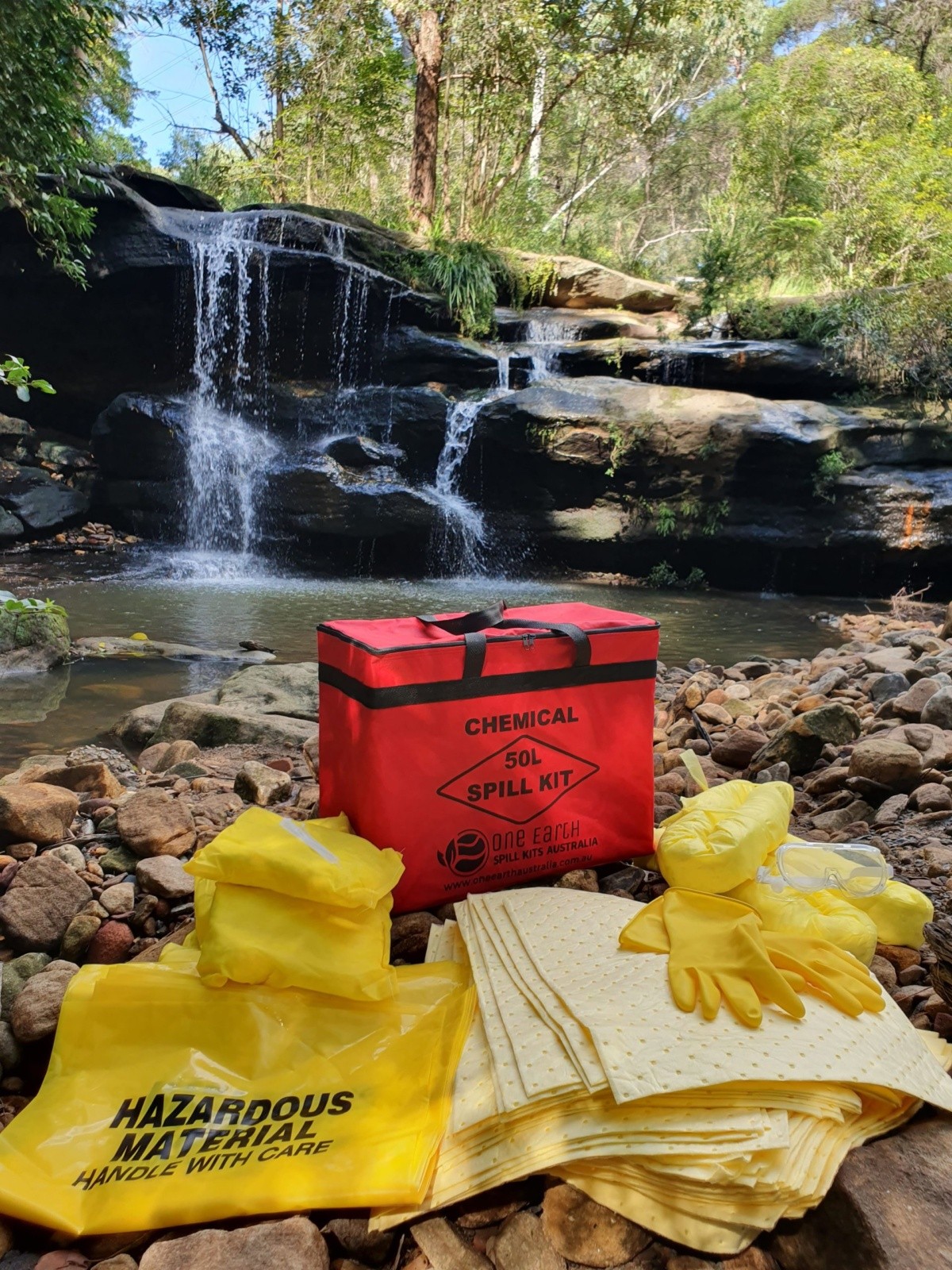A spill kit or spill response kit is a handy, mobile, and easy-to-use set of equipment used to safely and responsibly contain, decontaminate, clean up, and dispose of hazardous and non-hazardous spills such as chemicals or oils.
In this blog, we will break down the contents of a basic spill kit to help you understand why each component is provided in the spill kit, and how to best use each component of a spill kit to achieve a safe and responsible spill response.
Before you buy a spill kit you should check the contents to make sure they are suitable for your specific needs. Factors you may need to consider include the type of potential spills at your workplace (for example oils, fuels, or harsh chemicals), and the size of any potential spills.

Remember: In emergencies, it is important to be familiar with your spill kit so you can act swiftly. It is best practice to always be prepared!
- The Spill Kit Container
- Absorbent Booms
- Absorbent Pillows
- Absorbent Pads
- Personal Protective Equipment (PPE)
- Contaminated Waste Bags & Ties
- Instruction Card or User Guide
The Spill Kit Container
Generally speaking, the containers of spill kits are usually heavy duty carry bags or wheelie bins of some description. These heavy-duty carry bags or wheelie bins should be clearly visible and correctly labelled so they are easily accessed in the case of an emergency. They should be clearly marked “Spill Kit” and also the type of spill kit (such as General Purpose, Oil & Fuel, or Chemical).
Spill kits are often colour coded to represent the type of spill kit (for example, General Purpose spill kits are blue, Oil & Fuel spill kits are yellow, and Chemical spill kits are red). Often, they are also marked with the capacity of the spill kit (such as 50L or 120L).
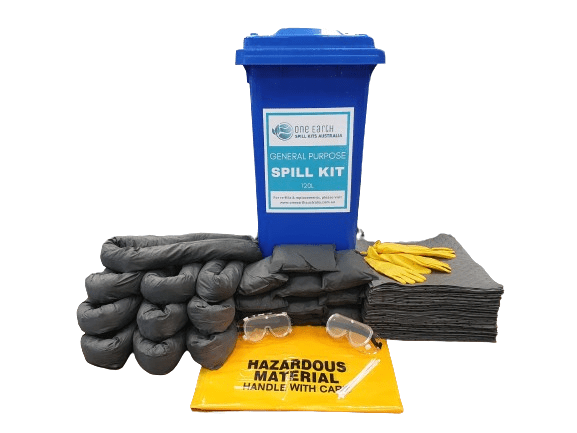
Important: A good spill kit container should be portable, and allow quick and easy transportation to the spill location
Absorbent Booms
Absorbent booms, also referred to as absorbent socks, are “sausage” shaped absorbents that are used for perimeter containment. They should be placed around the spill, particularly if the spill is spreading, moving toward drains, or any other environmental release.
The purpose of absorbent booms is to isolate the spill and keep the spill from spreading. It is important that the spill does not travel, and a stationary spill will make for a more safe and efficient clean-up.
If there has been a spill of hydrocarbons in water, oil & fuel absorbent booms can be placed around the spill as they do not absorb water, and they will float on top of the water and stop the hydrocarbons from spreading, which could create an environmental disaster. Even after full absorption of the spill, absorbent booms will continue to float on top of the water, facilitating ease of disposal.
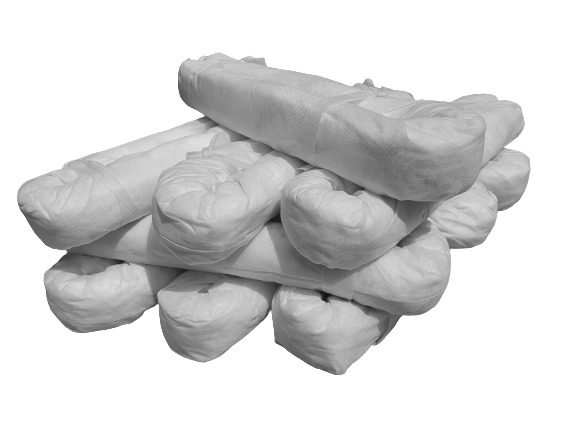
1.2m Oil & Fuel Absorbent Booms
Absorbent Pillows
Absorbent pillows are the most effective absorbent for constant leaks and high-volume spills. Simply place them underneath the leak or on top of the spill and they will absorb a large quantity of the liquid.
Oil & Fuel absorbent pillows can be applied to land and water spills. They will float on top of water even after full absorption, so you can safely and responsibly dispose of them after use.

Oil & Fuel Absorbent Pillows
Absorbent Pads
Absorbent pads are versatile and easy-to-handle absorbents used to soak up shallow spills and then effectively wipe and clean up the remaining spill after booms and pillows have been utilised.
Absorbent pads directly soak up the spill, much like a sponge. Absorbent pads should be used to clean up the spill from the outside toward the middle. They can also be used to wipe down walls and equipment that have been affected by the spill.
Again, Oil & Fuel absorbent pads can be applied to land and water spills, and will not absorb water.

Oil & Fuel Absorbent Pads
Personal Protective Equipment (PPE)
Whenever you are tasked with cleaning up a spill there is a risk of harm. Spill kits should always include PPE to protect you from injury and harm whilst cleaning up a spill.
Many chemicals are hazardous and corrosive and can pose a significant risk of harm. Although the type of PPE will vary from spill kit to spill kit, generally speaking, there should be protective eyewear (to protect your eyes from chemicals splashing up for instance), and also protective gloves to prevent direct contact of your hands with the spilled liquid, which could obviously pose a significant threat if you are handling hazardous chemicals for example.
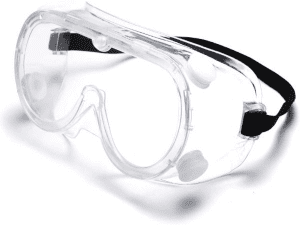
Contaminated Waste Bags and Ties
It is also important to dispose of your used absorbents and PPE safely and responsibly after your spill clean-up is complete. Spill kits will provide you with contaminated waste bags to place all your used absorbents and PPE inside of, and also ties to ensure the waste bags are properly secured to prevent any seepage or leaks from escaping.
Placing your used absorbents and PPE inside of the waste bags provides containment allowing them to be disposed of safely.
The disposable bags should be disposed of in accordance with local, state, and national EPA regulations. The disposal will depend on the properties of the liquids. If you are unsure, there are local waste departments you can call and make an enquiry.
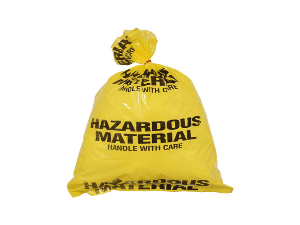
REMEMBER: Under WHS Regulations, you are obliged to clean up chemical leaks and spills immediately. This also includes safely disposing of the soiled absorbents and PPE and any effluent resulting from the spillage.
Instruction Card or User Guide
Most, if not all, spill kits will provide you with an instruction card detailing emergency spill response procedures. Users should familiarise themselves with this user guide in case of an emergency.
It is also recommended that once team members have been designated for spill response, they are given training in how to use the spill kit effectively and safely. A business-specific spill response plan should also be developed and clearly documented.

This blog was aimed to give you some insight into the components of a spill kit and explain why each of the components is provided within the spill kit. It is important to familiarise yourself with your spill kit before an emergency spill may take place.

